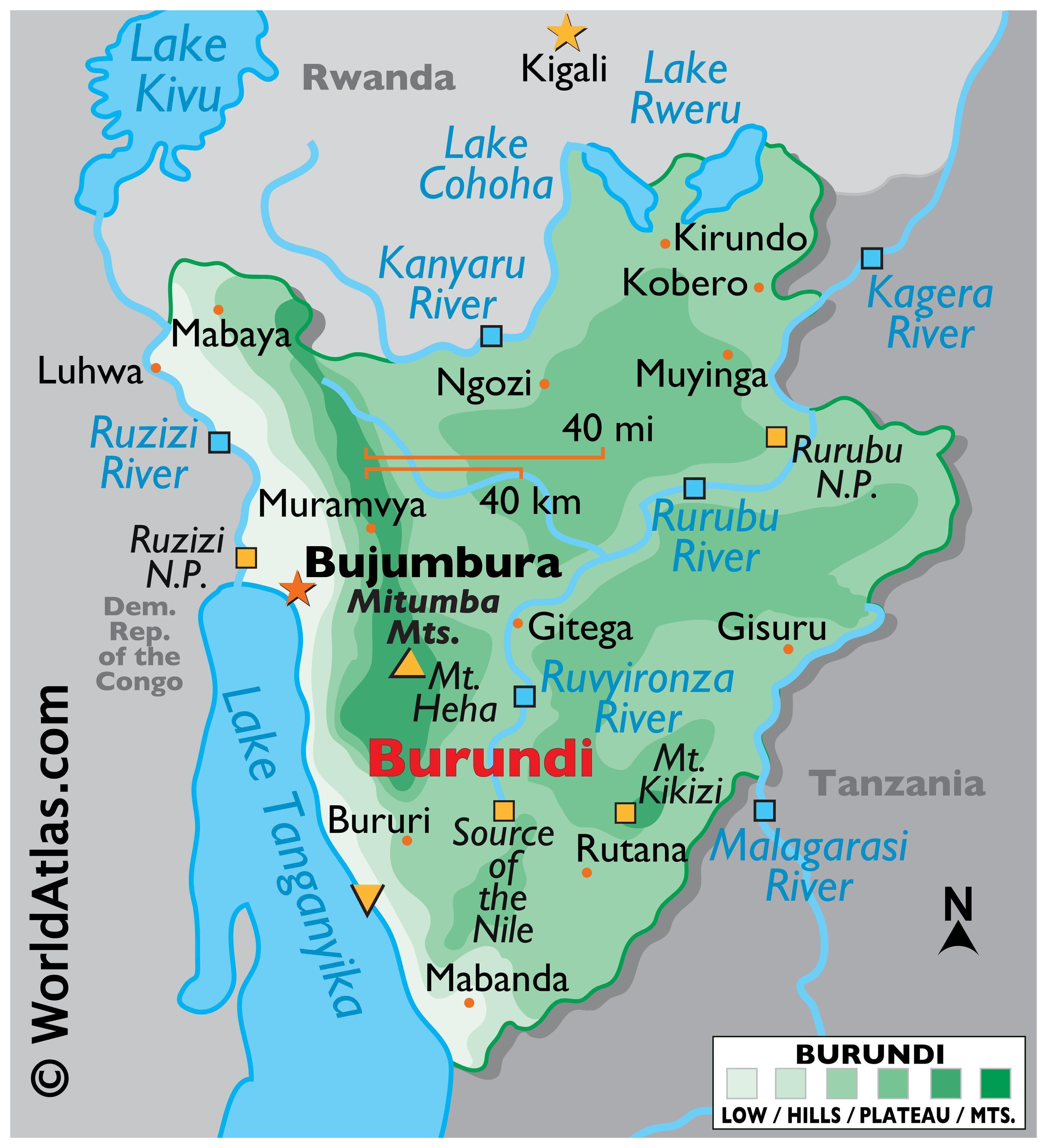General Country Information
- Official Name: Republic of Burundi
- Capital City: Gitega
- Official Languages: Kirundi, French, English
- Currency: Burundian Franc (BIF)
- Government Type: Presidential Republic
Geographical Location
- Continent: Africa
- Neighboring Countries: Rwanda to the north, Tanzania to the east and south, Democratic Republic of the Congo to the west
- Major Cities: Bujumbura, Gitega, Ngozi, Ruyigi

Map of Burundi
Brief History and Political Overview
- History: Burundi has a complex history marked by ethnic conflict between the Hutu and Tutsi populations. It gained independence from Belgium in 1962.
- Political Overview: Burundi is a presidential republic with a history of political instability. The current President is Évariste Ndayishimiye, who took office in June 2020 following the sudden death of his predecessor, Pierre Nkurunziza. Significant historical events include periods of civil war and efforts towards peace and reconciliation.
Religions and Cultural Highlights
- Religions: Christianity (predominantly Roman Catholic), indigenous beliefs, Islam
- Cultural Highlights: Burundi is known for its rich cultural heritage, including traditional drumming, dance, and crafts. The country celebrates various festivals and has a vibrant oral tradition.
Economy
GDP (Latest Available Data)
- GDP: $11.347 billion (2023 est. CIA Factbook)
Major Industries
- Agriculture (coffee, tea, cotton, maize, sorghum, sweet potatoes, bananas, manioc)
- Mining (nickel, gold, uranium, rare earth elements)
- Services (trade, transportation, banking)
Key Economic Indicators
- GDP Growth Rate: 4.3% (2024, IMF)
- Inflation Rate: 22% (2024, IMF)
- Poverty Levels: High, with around 75% of the population living below the poverty line
- Investment Climate: Challenging due to political instability, limited infrastructure, and regulatory hurdles

Economy of Burundi
Trade Statistics
- Main Export Partners: Democratic Republic of the Congo, United Arab Emirates, Pakistan, Belgium, Switzerland
- Main Import Partners: China, India, Tanzania, Kenya, Saudi Arabia
- Major Goods Traded: Exports include coffee, tea, minerals, and cotton; imports include petroleum products, foodstuffs, machinery, and equipment
Currency and Exchange Rates
- Currency: Burundian Franc (BIF)
- Exchange Rate: Approximately 1 USD = 2,045 BIF (2024)
Population
Total Population (Latest Available Data)
- Population: Approximately 13.5 million (2024, CIA Factbook)
Population Growth Rate and Demographic Trends
- Population Growth Rate: 2.81% annually (2024, CIA Factbook)
- Demographic Trends: High birth rate, young population
Age Distribution
- 0-14 years: 44%
- 15-64 years: 53%
- 65 years and over: 3%
Urban vs. Rural Population Distribution
- Urban Population: 13.7%
- Rural Population: 86.3%
Major Ethnic Groups and Population Diversity
- Hutu: 85%
- Tutsi: 14%
- Twa (Pygmy): 1%
Education Levels and Literacy Rates
- Literacy Rate: 68.4% (2022, World Bank)
- Education Levels: Primary education is more widespread than secondary and tertiary education
Workforce
Labor Force Size and Composition
- Labor Force Size: Approximately 5.2 million (2023 est.)
- Composition by Sector:
- Agriculture: 80%
- Industry: 6%
- Services: 14%
Unemployment Rate
- Approximately 0.9% (2024, Statista)
Workforce Skills and Education
- Limited formal training and higher education opportunities
- Predominantly agricultural skills
Labor Laws and Worker Rights
- Governed by the Labor Code of Burundi
- Rights include minimum wage, working hours, and conditions
- Issues with enforcement and informal sector employment
Migration Trends
- Inward: Limited due to economic conditions
- Outward: Significant emigration for economic reasons, particularly to neighboring countries and Europe
Natural Resources
List of Major Natural Resources
- Nickel
- Gold
- Limestone
- Peat
- Rare earth elements
- Arable land
- Freshwater resources
Top Minerals (in order of economic importance)
- Nickel
- Gold
- Rare earth elements
- Limestone
- Peat
Annual Production Volumes for Key Minerals
- Nickel: Estimated reserves, production not yet substantial
- Gold: Approximately 1,800 kg annually
- Limestone: Used primarily for local construction
Update on Renewable Energy
- Hydropower potential is significant
- Growing interest in solar and biomass energy projects
Mining and Natural Resources Laws and Regulations
Key Laws Governing Mining and Natural Resource Utilization
- Mining Code (2013): Governs all mining activities[https://www.a-mla.org/en/country/Burundi]
- Environmental Code (2000): Ensures environmental protection in mining [https://www.dbsa.org/sites/default/files/media/documents/2021-05/Chapter%205%20Burundi.pdf]
Regulatory Bodies and Their Roles
- Ministry of Energy and Mines: Oversees mining activities and policy
- National Institute for Environment and Nature Conservation: Monitors environmental impacts
Recent Changes in Legislation
- Ongoing efforts to update mining regulations to attract foreign investment
- Emphasis on sustainable development and environmental protection
Visual Aids

Flag of Burundi
Sources
- World Bank – https://data.worldbank.org/country/burundi
- CIA World Factbook – https://www.cia.gov/the-world-factbook/countries/burundi/
- African Development Bank – https://www.afdb.org/en/countries/east-africa/burundi/burundi-economic-outlook
- Government of Burundi websites and publications
- Statista – https://www.statista.com/outlook/co/socioeconomic-indicators/burundi
- IMF – https://www.imf.org/external/datamapper/profile/BDI
